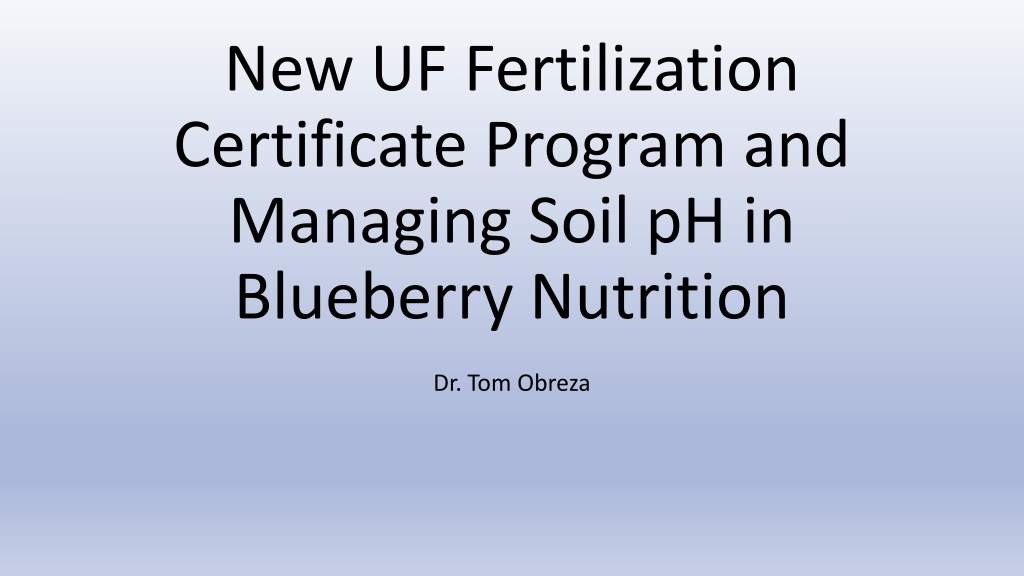New UF Fertilization Certificate Program and Blueberry Soil pH Management
Explore the new UF Fertilization Certificate Program offering courses in fertilizer science and technology, focusing on soil pH management for blueberry nutrition. The program includes required and elective courses, field visits, and opportunities for scholarships/internships. Targeted towards graduate students, growers, ag consultants, environmentalists, and state regulators, emphasizing practical skills and hands-on experiences in the field of fertilizer management.
Download Presentation

Please find below an Image/Link to download the presentation.
The content on the website is provided AS IS for your information and personal use only. It may not be sold, licensed, or shared on other websites without obtaining consent from the author. Download presentation by click this link. If you encounter any issues during the download, it is possible that the publisher has removed the file from their server.
E N D
Presentation Transcript
New UF Fertilization Certificate Program and Managing Soil pH in Blueberry Nutrition Dr. Tom Obreza
Fertilizer Science and Technology Graduate Fertilizer Science and Technology Graduate Certificate Certificate Official Start Spring term 2023 Requirements for Completion: A total of four courses, 3 core courses (9 credits), 1 elective course (3 credits) The courses for the certificate were existing with one recently approved Ongoing discussions with sponsors of field visits to observe fertilizer formulation facilities, field operations, and research sites Soliciting sponsors for Scholarship/internship opportunities
Required Courses Required Courses SWS 5115 Environmental nutrient management - 3 credits (on-line) Springs even years SWS 6136 Soil Nutrient Diagnostics for Ag Production - 3 credits (on- line) every Summer SWS 6117 - Fertilizer Technology, Production and Use 3 credits (online) Fall odd years approved in 2022 (on-line) first class Fall 2023 Fall even years
Elective Courses (Choose One) Elective Courses (Choose One) SWS 5234 Environmental soil, water, and land use - 3 Credits (on-line) every Fall SWS 6134 Soil quality -3 Credits(on-line) Fall even years AGR 6422C Environmental crop nutrition - 3 Credits (on-line) every Fall HOS 6412 Nutrition of horticultural crops - 3 Credits (on-line) every Spring
Target Audience Future Events Target Audience Future Events Graduate Students Growers Ag Consultants Environmentalists State Regulators Addition of graduate concentrations on fertilizer and irrigation management Field trips to be added with sponsor support Mining operations Fertilizer formulation facilities Research plots to view 4R related results Online and in-person fertilizer related seminar series
Best pH for Blueberry Production Recommendations below can be found in HS 1356 Nutrition and Fertilization Practices for Southern Highbush Blueberry in Florida. Blueberry plants evolved under acidic, low-nutrient conditions. Both Rabbiteye and Southern Highbush (SHB) thrive on acidic soils(the recommended pH range for blueberries is 4.5 5.5). Most Florida soils are low in organic matter, and generally have a pH higher than that required for good blueberry growth, health, and the uptake of certain nutrients. SHB are typically planted either directly into raised beds of milled pine bark or into soil beds that have been amended with pine bark providing organic matter and lower pH. Acid injection into drip irrigation systems, or soil applied sulfur, is often needed to maintain proper soil pH.
What is Soil pH? A measure of how acidic or alkaline a soil is. The pH scale ranges from 0 to 14, where a pH of 7 is neutral. The lower the pH value, the more acidic a substance is, while the higher the pH value is on the scale, the more alkaline (basic) it is. pH is logarithmic If you reduce the pH of your soil by 1 point, your soil becomes 10x more acidic. If you reduce the pH of your soil by 2 points, your soil becomes 100x more acidic. etc
Dissociation of water H2O H+ + OH- Water is both a weak acid and weak based since both H+ and OH- are produced. Pure water has a pH of 7 [H+] X [OH-] = [10-7 M] X [10-7 M] Water in equilibrium with atmospheric CO2has a pH of 5.5 5.7 H2O + CO2 H+ + HCO3- Concentration of H+ is expressed as pH 1 (? H2O + H+ H3O+ +) = -log(H+) Thus if H+ = 10-5, pH = 5 pH = log
Soil chemical and biological functions are influenced by pH Plant nutrient availability depends on nutrient concentration in solution Solubility of nutrients are dependent on both soil buffering capacity and cation exchange capacity pH determines rate of ammonia volatilization
What can change soil pH? 1. Nutrient leaching Nutrient leaching Largest effects on acid formation is leaching of dissolved and soluble ions below the crop root zone. Most soluble anions: NO3-, Cl-, HCO3-, and SO4-2 Most soluble cations: Na+, Ca+2, Mg+2, and K+ Leaching of cations reduce base saturation and pH
What can change soil pH? 2. Soil buffering capacity Soil buffering capacity The ability of the soil to resupply nutrients to solution. As plant roots absorb K+, K+on the CEC is desorbed to resupply solution K+. P is taken up and replaced by P minerals dissolved to resupply solution H2PO4 . Sandy soils have the lowest buffer capacity, so they can acidify faster because they don t resist the change in pH. For the same reason they can also be corrected the easiest. Example: Less lime is needed to increase the pH of acidic sandy soils compared with clay soils.
What can change soil pH? 3. Plant activity Plant activity Note: The figure below has root hairs that blueberry does not. Uptake occurs directly through the root surface. Plant can alter soil pH through imbalanced cation/anion uptake As cations are taken up by plant roots, electrical neutrality is maintained by uptake of anions or extrusion of H+ or an organic acid The opposite is also true, uptake in anions result in extrusion of OH- or HCO3- Excess cation uptake results in net increase in soil pH Leaching of NO3- and SO4-2 along with equivalent cations decrease soil pH
Roots acidify soil to solubilize nutrients Plants secreting H+by cellular respiration: CO2reacts with H2O to form carbonic acid (H2CO3) in the soil, which dissociates to add H+to the soil.
What can change soil pH? 4. Fertilizers Fertilizers Transformation of NH3 or NH4 fertilizer to NO3 in the soil produces large amount of H+ Soil acidification is increased when S and P sources are combined with NH4 The amount of H+ is relatively small and has little effect on bulk soil pH in the short term.
Soil pH affects nitrogen volatilization Soil pH can play a role in N volatilization losses. Ammonium (NH4+)in the soil solution exists in equilibrium with ammonia gas (NH3). The equilibrium is strongly pH dependent. The difference between NH3 and NH4+ is one H+ ion. For example, if NH4+ were applied to a soil at pH 7, the equilibrium condition would be 99% NH4+ and 1% NH3. At pH 8, about 10% would exist as NH3 gas. This means that ammonium N sources will volatilize more at higher soil pH. Special note about urea (46-0-0): It converts to ammonium carbonate, creating its own high pH environment.
Soil pH affects micronutrient availability Micronutrients important for blueberry production include iron, manganese, zinc, copper, and boron. Example: Fe may be present in the soil in sufficient quantities but unavailable for plant uptake at higher soil pH. Pine bark contains micronutrients such as Mn, along with lowering soil pH.
Summary Know your soil pH! Know the pH scale and what it means. Be aware that soil pH affects chemical and biological functions, in particular plant nutrient availability. Know (and manage) the causes of pH change in Florida sandy soils: Nutrient leaching (pH ) Low soil buffering capacity (pH or ) Plant growth and residue decomposition (pH ) Fertilizer choices (pH or or neutral) Irrigation water (pH )























